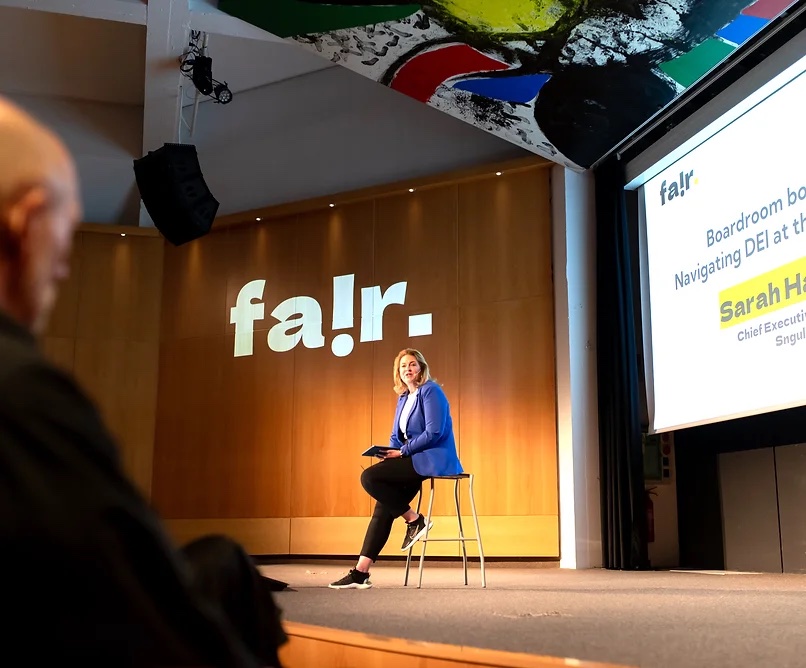5 min. read
How to Allocate Budget for DEI
What You Need to Know – Insights from Oana Iordachescu

Want to Budget for Inclusion? Keep reading.
Effectively allocating a budget for DEI efforts requires strategic planning and a deep understanding of organisational needs. In this interview, we speak with Oana Iordachescu, to explore practical approaches for ensuring that DEI initiatives are not just well-intentioned, but also well-funded and impactful.
Meet Oana Iordachescu
Oana is leading Fair Cultures, partnering with visionary organisations to implement workplace inclusion strategies building a more human-centric, resilient business ecosystem.
Additionally, she is the conference director of the first European Workplace Inclusion conference in Barcelona and launched a series of Masterclasses curated for Inclusive People Leaders in Berlin, Amsterdam, Madrid and Lisbon.
With over 15 years of experience in people management, talent acquisition, and DEI strategy program management, she has dedicated her career to fostering inclusive workplaces and driving impactful organisational change. Her journey spans leadership roles in prominent global organisations, including Meta, Booking.com, Zalando, Wayfair, and Criteo, where she has consistently delivered on the promise of equal opportunity and workplace inclusion through strategic, data-driven, and empathetic approaches.
What are the key factors to consider when allocating a budget for DEI initiatives?
When (what time of year) and where to start?
When we talk about allocating budgets for DEI initiatives, we’re really talking about how we value belonging and connection in our organisations. It takes courage to look at our financial structures and ask, “Where do our true priorities lie?”
First, we need to understand our organisation’s fiscal rhythm. This isn’t just about numbers; it’s about the story our budget tells about what we truly believe is important. When does your organisation draw the line between fiscal years? When do they calculate revenue and profit? These timelines shape the narrative of our priorities.
Second, we must be honest about where DEI efforts currently sit within our organisation. In younger companies just beginning their DEI journey, there might not be a dedicated budget. And that’s okay – it’s a starting point. Often, these initiatives are supported by talent acquisition teams eager to build diverse teams, or by individual departments that recognise the power of diverse perspectives. The key is to acknowledge where we are without judgment, and to move forward with intention.
Lastly, and perhaps most importantly, we need to create a culture of accountability. Who will be responsible for reporting on the results of our DEI investments? This isn’t about assigning blame, but about fostering a sense of shared responsibility and commitment to growth.
Remember, different departments may have different realities when it comes to diversity and inclusion. Acknowledging these differences isn’t about pointing fingers; it’s about seeing clearly so we can move forward together.

Can you provide examples of high-impact DEI initiatives that should receive significant budget allocation?
When we invest in DEI initiatives, we’re really investing in the heart of our organisation – in the people who show up every day, bringing their whole selves to work. Here are some high-impact areas that deserve our attention and resources:
– Dedicated DEI personnel: This is about more than just creating a new position. It’s about saying, “This matters enough to us that we’re going to have someone whose entire job is to help us grow in this area.” Whether it’s a DEI manager or specialists embedded in key departments, these individuals can help weave inclusion into the very fabric of our organisation.
– Annual audits on inclusion and fair pay: These audits aren’t just about compliance; they’re about people and their experience in your organisation. They require us to look at hard truths about where we might be falling short. But here’s the beautiful thing: when we have an open view and see clearly, we create the opportunity for real change. These audits often lead to increased engagement and allyship throughout the organization.
– Representation and compliance initiatives: This is where we put our money where our values are. Are we truly creating space for everyone, including those with disabilities, returning parents, women in leadership and do we understand the legal framework why they are protected demographics? When we invest in true representation, we’re investing in the richness of our collective creativity and innovation.
How do you balance long-term DEI goals with short-term needs when budgeting?
Balancing long-term vision with short-term action is all about embracing what I call “the messy middle.” For organisations just starting their DEI journey, it’s important to give yourself permission to start small and learn as you go.
Short-term pilots and initiatives allow us to practice, to stumble, to learn, and to grow. They give us the opportunity to see who in our organization is truly ready to step into this work with their whole heart. It’s okay if not everyone is there yet – change is a process, and we need to honour where each person is on their journey.
As you move forward, celebrate the small wins. Use them as building blocks for your longer-term vision. Remember, meaningful change doesn’t happen overnight, but every step forward is progress.

How do you prioritise different DEI initiatives when planning the budget?
When it comes to prioritising DEI initiatives, we need to start with honest self-reflection. It’s not about following a preset formula or chasing percentages. It’s about looking with curiosity and openness at our organisation’s unique challenges and opportunities.
Focus first on two visible aspects:
1. Representation: Who has a seat at the table? Whose voices are we hearing?
2. Engagement and Inclusion: Once people are in the room, do they feel truly seen, heard, and valued?
Then, dig deeper into two less visible, but equally crucial areas:
1. HR Technology: Are our systems and tools supporting our DEI goals, or are they perpetuating hidden biases?
2. Processes for addressing discrimination and harassment: Do we have robust, legally sound, as well as compassionate systems in place for when difficult situations arise?
Only after we’ve done this hard work can we start to allocate our budget effectively. The specific breakdown – whether it’s for training, employee resource groups, or events – should flow naturally from the needs we’ve identified through this process self-examination.
What metrics or KPIs do you use to evaluate the effectiveness of DEI spending?
When it comes to measuring the effectiveness of our DEI efforts, it’s important to remember that behind every metric and KPI are real human experiences. That said, we do need ways to track our progress and hold ourselves accountable.
The most effective approach is often to use whatever framework your organization already uses for other initiatives.
This creates a sense of familiarity and integration – DEI isn’t separate from your core business; it’s an integral part of it.
Indicators related to demographics, pay gaps, inclusion scores, inclusive leadership are always a good start. For most of my corporate experience, we were using OKRs and that was fine, the key is to ensure that everyone understands the commitments and can speak the same language about results. More recently internally at Fair Cultures, we focus more on NCTs (Narratives, Commitments, Tasks) which is more adapted to our needs as we work remotely and everyone is new.
Can you provide tips on how to make a compelling business case for DEI budget allocation to stakeholders?
Making a compelling case for DEI budget allocation is all about connection and storytelling. It’s about helping stakeholders see not just the numbers, but the human impact and potential of this work.
Start by truly understanding your audience. What matters most to them? What keeps them up at night? Then, connect DEI initiatives to those concerns:
– For C-suite executives, frame DEI in terms of overall organizational health, innovation, and bottom-line impact. Share stories of how diverse teams have driven success in other companies.
– For middle managers, focus on team dynamics, productivity, and talent retention. Help them see how DEI initiatives can make their teams stronger and their own jobs more rewarding.
Most importantly, be authentic. Share your own journey and why this matters to you personally. Vulnerability can be a powerful tool in helping others connect with the importance of this work.
How can smaller organisations or those with limited budgets still make meaningful investments in DEI?
For smaller organisations or those with limited budgets, remember this: it’s not about the size of your budget, but the depth of your commitment. Here’s how you can make meaningful progress:
1. Start with pilot programs: These allow you to learn and adapt without overwhelming your resources.
2. Focus on personal commitment: DEI isn’t just about programs; it’s about how we show up every day. Encourage leaders to model inclusive behaviors.
3. Prioritise visible changes: Focus first on representation and creating a sense of belonging. These visible changes can create momentum for deeper, systemic changes down the line.
Remember, every step forward, no matter how small, is progress. Celebrate these wins and use them to build support for larger initiatives in the future.
What emerging areas or trends should organisations consider investing in for future DEI efforts?
As we look to the future of DEI, two key areas are emerging that require our attention and investment:
1. Hybrid/remote work: This shift is fundamentally changing how we connect and collaborate. We need to ensure that our DEI efforts evolve to create belonging in both physical and virtual spaces.
2. Intergenerational collaboration: With more generations in the workforce than ever before, we have a unique opportunity to bridge divides and learn from diverse life experiences.
Technology will play a crucial role in addressing these trends, but remember: at its core, DEI is about human connection. Invest in tools that foster genuine interaction and understanding.
Equally important is doubling down on your organisation’s values and storytelling. In a rapidly changing world, a strong, inclusive culture can be an anchor that keeps everyone connected to your shared purpose.
What lessons have you learnt from past mistakes or successes in DEI budgeting?
The biggest lesson I’ve learned in DEI budgeting is this: progress over perfection.
It’s tempting to want to solve everything at once, to commit to sweeping changes across the organisation. But real, lasting change happens incrementally. Be realistic in your commitments. It’s better to fully follow through on a few key initiatives than to spread yourself too thin and leave people feeling disappointed or skeptical about DEI efforts.
Remember, DEI work is deeply personal and can be emotionally challenging. Budget not just for programs, but for support – for your DEI professionals, for employees engaging in this work, and for yourself.
Lastly, approach this work with humility and a willingness to learn. We will make mistakes along the way, and that’s okay. What matters is that we acknowledge those mistakes, learn from them, and keep moving forward with open hearts and minds. This journey of creating truly inclusive, equitable organisations is ongoing. It requires commitment, and compassion – for others and for ourselves. But it’s worth it.
Because when we create workplaces where everyone can bring their whole selves and feel truly valued, we unlock the full potential of our organisations and our communities.
Learn more about Fair Cultures
Fair Cultures partners with forward-thinking leaders to create high-performing, inclusive workplaces. They understand that when every employee feels valued and empowered, it drives innovation and engagement. Through strategic consulting, bespoke events, and data-driven strategies, they guide organisations in building cultures where diversity fuels creativity and inclusion accelerates growth. Their approach combines deep expertise with practical solutions: they analyse, they strategise, and implement to deliver measurable, lasting improvements to better your workplace culture, product impact and employer brand.
Diversity, Equity, and Inclusion (DEI) in the Workplace: they help organisations create environments where every individual feels valued, respected, and empowered to contribute their unique perspectives.
Work Culture Development: they guide companies in shaping positive, productive cultures that align with their values and drive long-term success.
Innovative Leadership: they equip leaders with the tools, mindset, and practices necessary to foster inclusive and high-performing teams.





